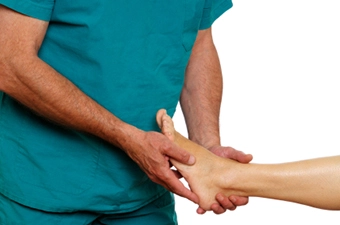Health Information

Foot Health Information
Your feet must last a lifetime, and most Americans log an amazing 75,000 miles on their feet by the time they reach age 50. Regular foot care can make sure your feet are up to the task. With proper detection, intervention, and care, most foot and ankle problems can be lessened or prevented.
The podiatrist is a doctor of podiatric medicine (DPM) also known as a podiatric physician or surgeon, qualified by his or her education and training to diagnose and treat conditions affecting the foot, ankle, and related structures of the leg. We are uniquely qualified among medical professionals to treat the foot and ankle based on our education, training and experience.
DPMs receive medical education and training comparable to medical doctors, including four years of undergraduate education, four years of graduate education and two or three years of hospital residency training. The podiatric medical school curriculum while covering the basic medical and clinical sciences also provides intensive focus on conditions of the foot and ankle. Within the field of podiatry, practitioners can focus on many different specialty areas, including surgery, sports medicine, biomechanics, geriatrics, pediatrics, orthopedics, or primary care.
Podiatrists are uniquely qualified to detect the early stages of diseases that exhibit warning signs in the lower extremities, such as diabetes, arthritis and cardiovascular disease, and we manage foot conditions which may pose an ongoing threat to a patient’s overall health.
Foot Care Tips
- Do not ignore foot pain. It is not normal for your feet to hurt. If you experience any persistent pain in the foot or ankle seek medical attention.
- Inspect your feet on a regular basis. Pay attention to any changes in color and temperature. Be aware of thick or discolored nails which may be a sign that you’re developing a fungal infection. Check for any cracks, cuts or areas of redness. Itching, peeling or scaling on the soles of the feet may represent Athletes foot. Be aware of any skin growth, lump or bump on your feet or ankles as this is probably not normal.
- Trim your toenails straight across and make sure they are not too short. Be careful not to cut the nails in the corners or on the sides as this can lead to ingrown toenails. They can be filed smooth with an emory board. Persons with diabetes or poor circulation should have their feet checked by a podiatrist.
- Feet should be washed regularly especially between the toes, be sure to dry them completely.
- Proper shoes are very important. Shoes should be purchased later in the day when your feet are more swollen. The shoe should be longer than your longest toe and the widest part of your foot should be at the widest part of the shoe. The shoe must be comfortable while trying it on at the shoe store, do not assume that it will mold to your foot. Make sure that you are wearing the same type of hosiery that you’ll be using with those shoes. Be sure to replace shoes that are worn out. We can measure your feet at our office if you desire.
- Make sure that you are using the right shoe for each sport or activity that you are engaging in. Running shoes should be used for running and not for side to side sports like racquetball where a cross training shoe would be more appropriate.
- Try to alternate your shoes wearing a different pair on subsequent days. For diabetics it is recommended that you change your shoes a few times during the day to avoid pressure spots.
- Avoid walking barefoot as you may injure your feet. Try to wear sandals when at the beach and don’t forget to use sunscreen.
- Be cautious when using home medications for foot ailments. Some of these products contain strong acid that may injure your foot. Diabetics need to be especially careful.
- Moisturize your feet. Use a moisturizer daily to keep dry skin from aging or cracking but do not use between the toes.
- Diabetic Patients – must be extra diligent about their foot care. Avoid wearing the wrong type of socks with tight elastic bands that can reduce circulation. Thick or bulky socks can fit poorly and irritate the skin. If your feet get cold at night wear your socks. Never use a heating pad.Check your shoes for any foreign objects such as pebbles before putting them on.Avoid getting your feet wet in snow or rain and never go barefoot. Do not smoke and make a sure you have excellent control of your blood glucose.If your vision is poor have a friend or family member check your feet on a regular basis.Diabetic patients should have a foot exam at least once a year.
